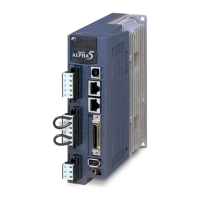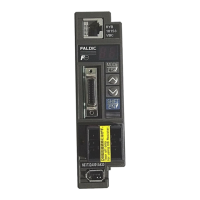CHAPTER 5 SERVO ADJUSTMENT Page: 297 5.1 Adjustment Procedure Outlines the general procedure for servo amplifier tuning, including mode selection and flowcharts.
5.2 Easy Tuning Explains the Easy Tuning function, operation profile, and provides fault indications and actions.
5.3 Auto Tuning Covers conditions for auto tuning, parameters used, approximate gain reference values, and adjustment procedures.
5.4 Auto Tuning Application Details parameters for auto tuning application, including manual adjustments for gain, filters, and torque settings.
5.5 Manual Tuning Provides conditions, parameters, and procedures for manual gain adjustment to achieve faster response.
5.7 Profile Operation Describes how to perform automatic operation using specified patterns, checking load conditions and effective torque.
CHAPTER 6 KEYPAD Page: 329 6.1 Display Describes the servo amplifier keypad, including seven-segment LEDs, keys, status LED, and mode functions.
6.2 Function List Lists functions available in parameter edit mode and positioning data edit mode, with indication and entry examples.
6.3 Sequence Mode Explains how to display the servo amplifier state and amplifier settings in sequence mode.
6.4 Monitor Mode Details how to monitor servomotor rotation speed, cumulative input pulse, and other parameters via the keypad.
6.5 Station No Mode Describes how to display and enter the station number of the servo amplifier.
6.6 Maintenance Mode Covers alarm display, alarm history, warning status, and cumulative time information accessible via the keypad.
6.7 Parameter Edit Mode Explains how to edit parameters via the keypad, including value indication, editing, and settling methods.
6.9 Test Operation Mode Provides instructions for test operations like manual operation, homing, position preset, and automatic operation using the keypad.
CHAPTER 10 PERIPHERAL EQUIPMENT Page: 425 10.2 Cable Size Recommends cable sizes for main circuit, control circuit, and encoder sections, including material and AWG relationships.
10.5 Surge Absorber Recommends surge absorbers for peripheral equipment like contactors and solenoids to suppress surge voltage.
10.6 Power Filter Suggests methods to counter radiant and conductive noise, including using power filters and conductive ducts.
10.7 AC;DC Reactor Details cases for connecting AC or DC reactors, including large power supply capacity, voltage imbalance, and harmonics suppression.
10.8 External Braking Resistor Specifies external braking resistors for large elevating loads or high operation frequencies, including selection tables.
10.9 Optional Equipment Lists and provides specifications for optional accessories like I/O cables, encoder cables, power cables, and brake cables.
CHAPTER 11 ABSOLUTE POSITION SYSTEM Page: 463 11.1 Specifications Lists specifications for the absolute position system, including battery backup method, max rotation range, and service life.
11.3 Connection Diagram Illustrates connection diagrams for VS Type and LS Type servo amplifiers, showing wiring for power, motor, and signals.
11.4 Starting Up Procedure Details the procedure for starting up the absolute position system, including battery installation, parameter setting, and homing.
11.5 Battery Warning Explains how battery warnings are issued and the methods to check battery status via OUT signal, PC Loader, keypad, or LED.
CHAPTER 14 APPENDIXES Page: 513 14.4 Parameter List Provides comprehensive lists of basic, control gain, automatic operation, extended function, and input/output terminal parameters.
14.6 Revision History Lists the revision history of the manual, including date of printing, index, and description of revisions.
14.7 Product Warranty Details the product warranty, including period, coverage, cases not covered, and malfunction diagnosis procedures.
14.8 Service Network Provides information on Fuji FA Service Centers and contracted service companies worldwide.
CHAPTER 5 SERVO ADJUSTMENT Page: 297 5.1 Adjustment Procedure Outlines the general procedure for servo amplifier tuning, including mode selection and flowcharts.
5.2 Easy Tuning Explains the Easy Tuning function, operation profile, and provides fault indications and actions.
5.3 Auto Tuning Covers conditions for auto tuning, parameters used, approximate gain reference values, and adjustment procedures.
5.4 Auto Tuning Application Details parameters for auto tuning application, including manual adjustments for gain, filters, and torque settings.
5.5 Manual Tuning Provides conditions, parameters, and procedures for manual gain adjustment to achieve faster response.
5.7 Profile Operation Describes how to perform automatic operation using specified patterns, checking load conditions and effective torque.
CHAPTER 6 KEYPAD Page: 329 6.1 Display Describes the servo amplifier keypad, including seven-segment LEDs, keys, status LED, and mode functions.
6.2 Function List Lists functions available in parameter edit mode and positioning data edit mode, with indication and entry examples.
6.3 Sequence Mode Explains how to display the servo amplifier state and amplifier settings in sequence mode.
6.4 Monitor Mode Details how to monitor servomotor rotation speed, cumulative input pulse, and other parameters via the keypad.
6.5 Station No Mode Describes how to display and enter the station number of the servo amplifier.
6.6 Maintenance Mode Covers alarm display, alarm history, warning status, and cumulative time information accessible via the keypad.
6.7 Parameter Edit Mode Explains how to edit parameters via the keypad, including value indication, editing, and settling methods.
6.9 Test Operation Mode Provides instructions for test operations like manual operation, homing, position preset, and automatic operation using the keypad.
CHAPTER 10 PERIPHERAL EQUIPMENT Page: 425 10.2 Cable Size Recommends cable sizes for main circuit, control circuit, and encoder sections, including material and AWG relationships.
10.5 Surge Absorber Recommends surge absorbers for peripheral equipment like contactors and solenoids to suppress surge voltage.
10.6 Power Filter Suggests methods to counter radiant and conductive noise, including using power filters and conductive ducts.
10.7 AC;DC Reactor Details cases for connecting AC or DC reactors, including large power supply capacity, voltage imbalance, and harmonics suppression.
10.8 External Braking Resistor Specifies external braking resistors for large elevating loads or high operation frequencies, including selection tables.
10.9 Optional Equipment Lists and provides specifications for optional accessories like I/O cables, encoder cables, power cables, and brake cables.
CHAPTER 11 ABSOLUTE POSITION SYSTEM Page: 463 11.1 Specifications Lists specifications for the absolute position system, including battery backup method, max rotation range, and service life.
11.3 Connection Diagram Illustrates connection diagrams for VS Type and LS Type servo amplifiers, showing wiring for power, motor, and signals.
11.4 Starting Up Procedure Details the procedure for starting up the absolute position system, including battery installation, parameter setting, and homing.
11.5 Battery Warning Explains how battery warnings are issued and the methods to check battery status via OUT signal, PC Loader, keypad, or LED.
CHAPTER 14 APPENDIXES Page: 513 14.4 Parameter List Provides comprehensive lists of basic, control gain, automatic operation, extended function, and input/output terminal parameters.
14.6 Revision History Lists the revision history of the manual, including date of printing, index, and description of revisions.
14.7 Product Warranty Details the product warranty, including period, coverage, cases not covered, and malfunction diagnosis procedures.
14.8 Service Network Provides information on Fuji FA Service Centers and contracted service companies worldwide.



